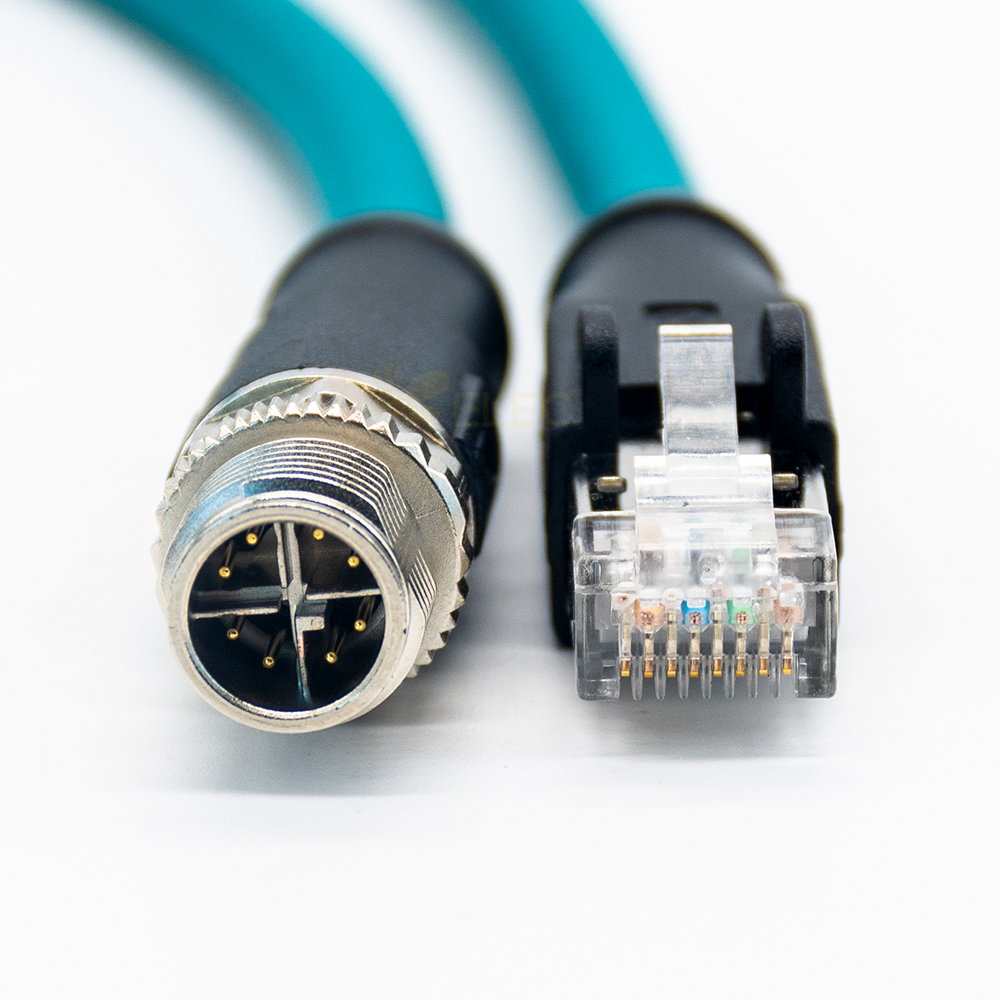序章
M12コネクタ堅牢性、信頼性、使いやすさにより、さまざまな業界で広く使用されています。 これらのコネクタには、さまざまな用途や要件に合わせてさまざまなタイプと構成があります。 この記事では、性別、コーディング オプション、終端タイプ、ピン構成、方向、シールド機能など、さまざまなタイプの M12 コネクタの詳細を詳しく説明します。 各オプションの詳細を理解することで、特定のニーズに合わせて M12 コネクタを選択する際に、情報に基づいた決定を下すことができます。
性別
M12 コネクタはさまざまな性別構成で利用でき、接続を確立する際の多様性を提供します。 さまざまなオプションを検討してみましょう。
オスコネクタ
オス コネクタには、対応するメス コネクタに差し込むピンが付いています。 これらは通常、接続の出力または送信端として使用されます。 オス M12 コネクタには、ストレート、角度付き、T 字型、Y 字型のデザインなど、さまざまな構成があります。 これらのオプションにより、ケーブル配線の柔軟性が向上し、狭いスペースや独自の方向での接続が可能になります。
メスコネクタ
メス コネクタには、オス コネクタのピンを受け入れるソケットがあります。 これらは、接続の入力端または受信端として機能します。 メス M12 コネクタには、ストレート、アングル、T 字型、Y 字型のデザインも用意されており、さまざまなケーブルの向きや取り付け要件との互換性が確保されています。 オスコネクタとメスコネクタの組み合わせにより、さまざまなシステムで信頼性の高い接続を確立できます。
オス対オス、メス対メス、オス対メスのコネクタ
スタンドアロンのオスおよびメス コネクタに加えて、M12 コネクタには特定の接続ニーズに対応できる構成もあります。 オス対オス コネクタおよびメス対メス コネクタでは、2 つのオス コネクタまたはメスコネクタを直接結合できますが、オス対メス コネクタはオス コネクタとメス コネクタの間のブリッジを提供します。 これらのオプションは、デバイスの接続または既存の接続の拡張における多用途性を提供します。

コーディングオプション
M12 コネクタは、誤接続を防止し、適切な嵌合を保証するためにコード化できます。 さまざまなコーディング オプションが利用可能で、それぞれが特定の目的に役立ちます。 M12 コネクタで一般的に使用されるコーディング オプションを見てみましょう。
A、B、C、および D コード化されたコネクタ
M12 コネクタは、A、B、C、および D コーディング オプションで利用でき、それぞれが異なるキーイング メカニズムを提供します。 このコーディングにより、異なるコードのコネクタが嵌合できないことが保証され、接続エラーのリスクが軽減され、システムの完全性が向上します。 各コーディング オプションは、特定のアプリケーション要件を満たすように設計されています。
- A コード コネクタは、M12 コネクタの標準コーディング タイプです。 これらは産業用途で広く使用されており、さまざまなデータおよび信号伝送のニーズをサポートします。
- B コードのコネクタは、産業用イーサネットや PROFINET などのイーサネット アプリケーション向けに特別に設計されています。 イーサネットベースのシステムに信頼性が高く安全な接続を提供します。
- AC 電源接続には C コード コネクタが使用されます。 より高い電流容量を備えており、産業環境での電力伝送に適しています。
- D コード コネクタはイーサネット アプリケーション向けに設計されており、より高いデータ転送速度を実現します。 これらは、要求の厳しい産業用ネットワーク設定でよく使用されます。
追加のコーディングオプション
標準の A、B、C、および D コーディング オプションに加えて、M12 コネクタには、K、L、S、T、および X コードなどの他のコーディング バリアントがある場合もあります。 これらのコーディング オプションは、特定のニッチなアプリケーションに対応し、特殊なシステム内での互換性を保証します。
終端タイプ
M12 コネクタには、ケーブルやデバイスへの取り付けと接続を容易にするさまざまな終端タイプが用意されています。 一般的な終了オプションを調べてみましょう。
ネジ終端
ネジ結線は、M12 コネクタの結線方法として一般的です。 ネジを使用してワイヤまたはケーブルをコネクタに固定し、信頼性の高い確実な接続を確保します。 この終端タイプは産業環境で広く使用されており、振動や環境条件に対する優れた耐性を備えています。
圧着端子
圧着終端では、圧着工具を使用して金属スリーブをワイヤストランドに圧縮し、確実な接続を作成します。 この終端方法は、高いレベルの信頼性と取り付けの容易さが要求されるアプリケーションで一般的に使用されます。 圧着接続は良好な導電性を提供し、機械的ストレスに耐性があります。
はんだ付け処理
はんだ終端では、ワイヤをコネクタ ピンに直接はんだ付けします。 この終端方法により、強力かつ永続的な接続が実現します。 高い耐久性と機械的強度が要求される用途によく使用されます。 はんだ付け接続により優れた導電性が得られ、振動や環境要因に対して耐性があります。

ピン配置
M12 コネクタにはさまざまなピン構成があり、さまざまなレベルのデータおよび電力伝送が可能です。 一般的なピンのオプションを見てみましょう。
- 2ピンコネクタ
- 3ピンコネクタ
- 4ピンコネクタ
- 5ピンコネクタ
- 6ピンコネクタ
- 8ピンコネクタ
- 12ピンコネクタ
これらのピン構成は幅広いアプリケーションに対応し、データ通信、電力伝送、制御信号に柔軟性をもたらします。
オリエンテーション
M12 コネクタは、特定の設置要件に対応するためにさまざまな方向で利用できます。 一般的なオプションを見てみましょう。
ストレートコネクタ
ストレート コネクタは直線的なデザインで、ケーブルの入口点と出口点が同じ方向に並んでいます。 ケーブルの配線と接続を簡単に行うのに最適です。
アングルコネクタ
角度付きコネクタは、設計に曲がりや角度があり、ケーブルの入口点と出口点を互いにオフセットさせることができます。 この設計により、ケーブル配線を特定の方向に向ける必要がある狭いスペースやアプリケーションでの接続が可能になります。
T 型コネクタ
T 字型コネクタは、1 つのケーブル入口点と、その入口点に対して直角に 2 つのケーブル出口点を備えた T 字型の構成を持っています。 ケーブル接続の分岐または分割に適しています。
Y型コネクタ
Y 字型コネクタは、1 つのケーブル入口点と 2 つのケーブル出口点が斜めに分岐した、文字 Y の形に似ています。 これらのコネクタは、単一のソースから複数の接続を必要とするアプリケーションに役立ちます。
適切な方向を選択することで、効率的なケーブル配線を確保し、特定の設置ニーズに合った接続を確立できます。
シールド付きコネクタとシールドなしコネクタ
M12 コネクタは、電磁干渉 (EMI) を軽減し、信号の整合性を確保する能力に応じて、シールド付きまたはシールドなしに分類できます。 これらのオプションを詳しく見てみましょう。
シールドコネクタ
シールド付き M12 コネクタには、EMI から保護する追加のシールド コンポーネントが備わっています。 コネクタを囲む金属シールドまたはシールド ジャケットが特徴で、電磁ノイズに対するバリアを提供します。 シールド コネクタは、産業オートメーション、ロボット工学、高速データ伝送など、EMI が懸念される用途に適しています。 要求の厳しい環境において、強化された信号の完全性と信頼性を提供します。
シールドなしコネクタ
非シールド M12 コネクタには追加のシールド コンポーネントがなく、一般にシールド付きコネクタよりもコスト効率が高くなります。 これらは、EMI が重大な問題ではない場合、または環境が重大な電磁干渉のリスクを引き起こさない用途に適しています。 非シールド コネクタは、要求の少ないアプリケーションで一般的に使用され、追加のシールドを必要とせずに信頼性の高い接続を提供します。
結論
M12 コネクタは、性別、ピン構成、コーディング、終端タイプ、方向、シールド機能に関して幅広いオプションを提供します。 それぞれのタイプと構成の詳細を理解することで、特定のアプリケーションのニーズに最適な M12 コネクタを選択できます。 オスまたはメスのコネクタ、ストレートまたはアングル設計、特定のピン数、特定のコーディング オプション、優先終端方法、またはシールド機能が必要な場合でも、要件を満たす M12 コネクタが用意されています。 適切な M12 コネクタを選択することで、さまざまな産業、オートメーション、およびネットワーキング アプリケーションで信頼性が高く効率的な接続を確保できます。






